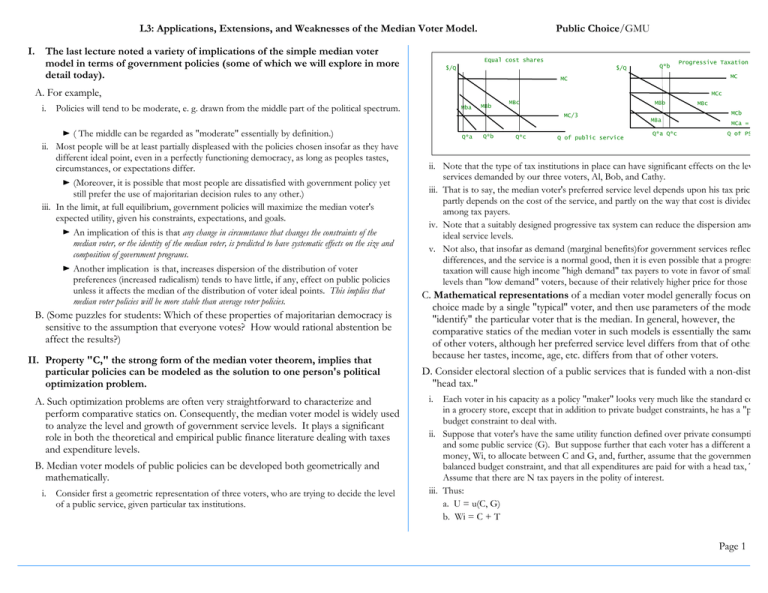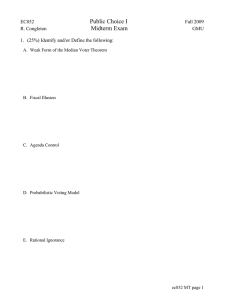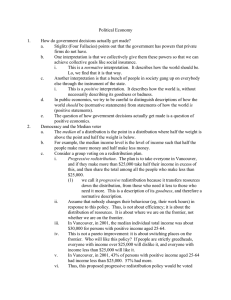L3: Applications, Extensions, and Weaknesses of the Median Voter Model.
advertisement

L3: Applications, Extensions, and Weaknesses of the Median Voter Model. I. The last lecture noted a variety of implications of the simple median voter model in terms of government policies (some of which we will explore in more detail today). Public Choice/GMU Equal cost shares $/Q $/Q Q*b Progressive Taxation MC MC A. For example, i. Policies will tend to be moderate, e. g. drawn from the middle part of the political spectrum. ( The middle can be regarded as "moderate" essentially by definition.) ii. Most people will be at least partially displeased with the policies chosen insofar as they have different ideal point, even in a perfectly functioning democracy, as long as peoples tastes, circumstances, or expectations differ. (Moreover, it is possible that most people are dissatisfied with government policy yet still prefer the use of majoritarian decision rules to any other.) iii. In the limit, at full equilibrium, government policies will maximize the median voter's expected utility, given his constraints, expectations, and goals. An implication of this is that any change in circumstance that changes the constraints of the median voter, or the identity of the median voter, is predicted to have systematic effects on the size and composition of government programs. Another implication is that, increases dispersion of the distribution of voter preferences (increased radicalism) tends to have little, if any, effect on public policies unless it affects the median of the distribution of voter ideal points. This implies that median voter policies will be more stable than average voter policies. B. (Some puzzles for students: Which of these properties of majoritarian democracy is sensitive to the assumption that everyone votes? How would rational abstention be affect the results?) II. Property "C," the strong form of the median voter theorem, implies that particular policies can be modeled as the solution to one person's political optimization problem. A. Such optimization problems are often very straightforward to characterize and perform comparative statics on. Consequently, the median voter model is widely used to analyze the level and growth of government service levels. It plays a significant role in both the theoretical and empirical public finance literature dealing with taxes and expenditure levels. B. Median voter models of public policies can be developed both geometrically and mathematically. i. Consider first a geometric representation of three voters, who are trying to decide the level of a public service, given particular tax institutions. MCc Mba MBb MBc MBb MC/3 Q*a Q*b Q*c Q of public service MBc MCb MBa Q*a Q*c MCa = 0 Q of PS ii. Note that the type of tax institutions in place can have significant effects on the level of services demanded by our three voters, Al, Bob, and Cathy. iii. That is to say, the median voter's preferred service level depends upon his tax price, wh partly depends on the cost of the service, and partly on the way that cost is divided up among tax payers. iv. Note that a suitably designed progressive tax system can reduce the dispersion among v ideal service levels. v. Not also, that insofar as demand (marginal benefits)for government services reflect inco differences, and the service is a normal good, then it is even possible that a progressive taxation will cause high income "high demand" tax payers to vote in favor of smaller se levels than "low demand" voters, because of their relatively higher price for those serve C. Mathematical representations of a median voter model generally focus on the choice made by a single "typical" voter, and then use parameters of the model to "identify" the particular voter that is the median. In general, however, the comparative statics of the median voter in such models is essentially the same as t of other voters, although her preferred service level differs from that of other vot because her tastes, income, age, etc. differs from that of other voters. D. Consider electoral slection of a public services that is funded with a non-distortin "head tax." i. Each voter in his capacity as a policy "maker" looks very much like the standard consum in a grocery store, except that in addition to private budget constraints, he has a "public budget constraint to deal with. ii. Suppose that voter's have the same utility function defined over private consumption (C and some public service (G). But suppose further that each voter has a different amou money, Wi, to allocate between C and G, and, further, assume that the government face balanced budget constraint, and that all expenditures are paid for with a head tax, T. Assume that there are N tax payers in the polity of interest. iii. Thus: a. U = u(C, G) b. Wi = C + T Page 1 L3: Applications, Extensions, and Weaknesses of the Median Voter Model. c. g(G) = NT iv. Note that T can be written as T = g(G)/N and substituted into the private budget constraint to make a single unified budget constraint: a. Wi = C + g(G)/N b. This in turn can be solved for C and substituted into the utility function: c. U = u( Wi - g(G)/N, G) v. Differentiating with respect to G yields a first order condition that characterizes the median voter's preferred government service level: a. - UC (gG/N) + UG = 0 = H or equivalently as UC ( gG/N) = UG b. The right hand side of the latter is the subjective marginal benefit (marginal utility) of the government service, the left-hand term is the subjective marginal opportunity cost of government services in terms of lost private consumption. c. Note that the subjective marginal cost of the service is determined by both preferences (marginal utility of the private good C) and objective production or financial considerations, cG/N. The latter can be called the median voter's marginal cost share, or price for the government service. vi. An implication of the first order condition together with the implicit function theorem is that each voter's demand for public services can be written as: a. Gi* = γ(Wi, N) that is to say, as a function of his own wealth (holding of the taxable base) and the population of tax payers in the polity of interest. b. The implicit function differentiation rule allows one to characterize comparative statics of how changes in wealth, Wi, and number of tax payers, N, affect a voter's demand for government services. c. Specifically G*W = HW/-HG and G*N = HN/-HG where H is the first order condition above. d. Recall that solving for these derivatives requires using the partial derivative version of the composite function rule and paying close attention to the location of all the variables in the various functions included in "H," the first order condition. We find that: G* and W = [- UCC (gG/N) + UGW] / 2 -[U CC (gG/N) - UC (gGG/N) -2 UCW (gG/N) + UGG] > 0 G* 2 2 2 N = [- UCC (gG/N)( g(G)/N ) + UC (gG/N ) + UGW(g(G)/N )]/ 2 -[U CC (gG/N) - UC (gGG/N) -2 UCW (gG/N) + UGG] > 0 Public Choice/GMU vii. Moreover, since demand is strictly increasing in W, this implies that the median voter is the voter with median income. a. It is this voter, whose demand for public services will lie in the middle of the distribution. b. The voter with median income has a preferred service level G** such that the same number of voters prefer service levels greater than G** as those who prefer service levels lower than G**. c. The comparative statics of a voter with median income can, in this case, be used to characterize the course of government spending through time, as other variables cha here, exogenous shocks to W or N, changes in tastes, etc.). E. Other, somewhat richer, mathematical models can be built to analyze such proble as: i. The effects of different tax instruments: proportional and progressive tax instruments ii. Optimal redistribution motivated by narrow self interest and/or altruism iii. the effects of varying degrees of publicness on demand for services: club goods F. For example, Meltzer and Richardson provide a Spartan but sophisticated analysi how the median voter model can be used to represent the equilibrium size of government in a pure transfer model of government policies. G. It bears noting that not every median voter model has unambiguous predictions about the effects of changes in the parameters of the median voter's choice problem on the median voter's demand for a given public policy. i. However, useful insights may be obtained about the relationships between the median voter's own choice setting and the parameters of public policy formation are obtained e in those cases. ii. In either case, the final test of the model is empirical, how well the median voter representation of a given policy fits the real world data on that policy. III. On the Normative Properties of Median Voter Policies A. Although the median voter model implies that the median voter gets what "he wants," it does not imply that public policies will be efficient in the usual Paretian sense. i. This can be seen mathematically by comparing the service level in the above model with that which would be Pareto efficient in a society of three individuals with different taste wealth. [ Recall that the Pareto Efficient level can be characterized with a social welfare function, or by maximizing one person's utility while holding the other's constant. lecture notes.] e. That is to say, with head tax finance, each voter's demand for a pure public service rises with personal wealth and with population. Page 2 L3: Applications, Extensions, and Weaknesses of the Median Voter Model. ii. Alternatively, one can develop a graphical illustration that demonstrates that the median voter will prefer an output (or other policy level) that is Pareto inefficient whenever the median and "average" voter have different ideal points. B. The median voter model developed to this point has ignored information costs faced by all voters which might lead voter's to be less than perfectly informed about their tax burdens or the benefits of public programs. i. In the case where the median voter's expectations are unbiased estimates of the consequences of public policies, he/she will still on average get what he/she wants. ii. In cases where rational ignorance implies biased expectations about the consequences of policies (as for example when one remains entirely ignorant of some policy detail or implication) then the median voter may not even get what he/she truly wants. C. Information problems open the door to interest groups and the bureaucracy who may manipulate voters by appropriately subsidizing various kinds of information and allow malfeasance (agency costs, bribery) on the part of elected and unelected government officials. i. Such problems would not exist if voters were completely informed about government policies and electoral competition was "perfect" in the sense that it lead to median voter policies. ii. [Student puzzle: why?] iii. Indeed, it can be argued that essentially the whole special interest group/rent-seeking literature is predicated on informational problems of these kinds in open democratic societies. IV. A Theoretical Weaknesses in the Median Voter Model A. There is one nearly devastating weakness to the median voter model, namely "the median voter" does not always exist in even an analytical sense. i. Duncan Black is the modern (re) discoverer of the idea of electoral cycles in one dimensioned policy spaces. a. In some, fairly unlikely, one dimensional arrays of voter preferences, the majority rule preference ordering may be non-transitive and no median voter would exist. Illustration of Cyclic (Non-transitive) Majorities Preferences Policies Al (utility) Bob (utility) Cathy (utility) referenda outcomes I 1 3 2 II > I II 2 1 3 III > II III 3 2 1 I > III Public Choice/GMU c. Single peaked preferences are sufficient to guarantee the existence of a median voter in one dimensional issue spaces. d. Note that if you plotted policies I, II, and III along the "x-axis" and utiities in the "y-axis," Al and Cathy have "single peaked preferences" (only one high point) whereas Bob's ordering has two peakes, it is V-shaped, with a peak at policy I and another at policy III. (Spacial voters of the sort we have modeled in previous lectures, always have single peaked preferences.) [Student puzzle: why?] ii. In 2-dimensional cases, however, a median voter exists ONLY in cases where voter preferences over policies are very symmetrically arrayed (see Plott, 1969). a. For example, preferences may all lie along a single straight line, or surround a single voter in the middle of a distribution of preferences, as with a "5" on a typical pair of b. In most other plausible looking 2-D policy space diagrams, cycles occur even if vote preferences are single peaked! c. Consider for example the case in which voter preferences form a triangle. In a two dimensional diagram over "guns and butter," a voter's ideal platform is a specific combination of "guns and butter" which can be represented as a single poi The indifference curves of spatial voters are indifference curves. Note that in the triangular case, every policy has a non-empty win set, even when all vo have single peaked preferences. d. Def: The win set of policy "z" is the set of policies which could beat "z" in a major rule election or referendum. In a three person diagram, these are the policies that can make two of the three pe better off than at "z." iii. The possibility of majoritarian cycles is generally regarded as a problem because it impli that there may be no majority decision, and/or if there is one, the result is arbitrary. Buchanan, however, has argued that "cycling" can, perhaps surprisingly, be a good property of majority rule systems insofar as it promotes equity. With cycling, everyone eventually gets to be a member of the majority coalition at point and so will not be perpetually exploited. B. Fortunately for those who like simple models of the world, there is a large body o empirical evidence that suggests that public policies reflect median voter interests and change when median voter interests and circumstances change. i. For example, the median voter model has a good empirical track record in Public Finan as a model of government program size across states and through time. ii. Although the theory may be said to rest on "unlikely" assumptions about the distributio voter preference, estimated median demand functions for public service can account a good deal of the observed variation in actual public services. Page 3 L3: Applications, Extensions, and Weaknesses of the Median Voter Model. Public Choice/GMU C. There are a number of possible explanations for the empirical results in support of the median voter model and also for the "surprising stability" of government policies. i. First we could be lucky regarding the distribution of voter preferences. a. It is possible that voter preferences over policies are (largely) of the sort which can be mapped into a single issue space while retaining "single peakedness." b. For example, the work of Poole and Daniels (APSR, 1985) suggests that the distribution of policy preferences tend to be fundamentally "linear" and stable. c. Using an enormous data set of roll call voting from the American Congress, they demonstrate that a single dimension (the left-right political spectrum) to predict more than 80% the votes cast by representatives in the US Congress (over all recorded votes). ii. If voter preferences are fundamentally fairly similar over goods and services, the observed variation in preferences over policies may reflect difference in income. iii. If voter preferences are fundamentally fairly similar, the observed variation in policy preferences may also reflect different voter ideologies used to estimate the consequences of alternative policies. It may be the the distribution of "estimators" is more or less one dimensional insofar as ideological models of the world tend to lie along a one-dimensional ideological spectrum. In that case, differences in voter estimates of policy would cause them to have policy preferences that lie along an essentially one dimensional spectrum rooted in the ideological spectrum. In that case, it could be said that the "one-dimensional debates" of political philosophers tend to "create" voter preferences over public policies that are also essentially one dimensional. D. The emergence of two party or two coalition political systems (as with Duverger's theory of parties, which we will discuss later) also tends to reduce the dimensionality of the voting space insofar as a straight line through any two party platforms tends to be generate a "one dimensional" of policy alternatives, essentially those between the main party platforms. Page 4



